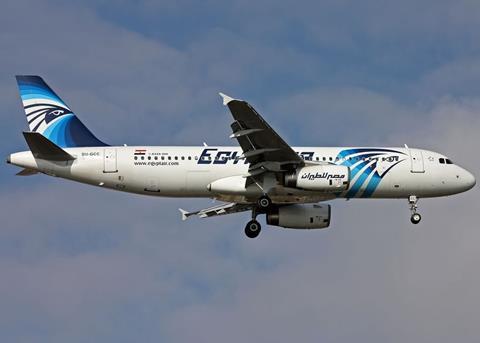After an eight-year inquiry, Egyptian investigators have controversially concluded that ignition of explosive material behind the cockpit of an EgyptAir Airbus A320 resulted in a fire and the loss of the aircraft, an explanation dismissed by French counterparts.
The twinjet – operating from Paris Charles de Gaulle to Cairo on 19 May 2016 – came down in the Mediterranean Sea after radar contact was lost in Egyptian airspace, with the aircraft at 37,000ft some 7nm south of the KUMBI waypoint.
None of the 66 occupants on board the aircraft (SU-GCC) survived.
The inquiry has been the subject of friction between French and Egyptian air accident investigation authorities, with France’s BEA arguing that evidence from the cockpit-voice recorder, avionics and debris point to a rapidly-developing cockpit fire.
According to the Egyptian air accident investigation department’s newly-released final conclusions, three scenarios were drawn up to explain the loss of the jet.
It considered whether the fire started on the first officer’s side, enriched by an oxygen leak, a scenario consistent with a hissing sound heard on the cockpit-voice recorder.
But the inquiry argues that the triggering of a lavatory smoke warning before an avionics smoke warning, and damage analysis of aircraft components, suggest the fire did not originate in the cockpit.
It also refers to forensic conclusions that injuries to some passengers were associated with high-explosive materials such as TNT.
The other two proposed scenarios both involve the detonation of explosives in the galley just behind the cockpit.
One of these two scenarios, focusing exclusively on a galley explosion, has been ruled out because it does not explain the hissing sound.
The other scenario accounts for the hissing by suggesting a more complicated chain of events, with the explosion causing a fire which propagated to the area of the first officer’s oxygen system. The inquiry claims this is consistent with flight-recorder information and smoke-alarm timings.
“There was no evidence of any firefighting activities inside the cockpit,” it states. “This supports that fire was originated outside the cockpit.”

But the 663-page final report includes over 140 pages of information and analysis from BEA, which concludes that the accident sequence began with the flow of oxygen via the first officer’s mask regulator.
BEA could not determine whether the flow was linked to a human action, but the noise of the flow could be heard in the cockpit, and the storage box for the first officer’s mask became “highly enriched” with oxygen as a result.
Cockpit-voice recorder information neither confirms, nor refutes, a hypothesis that a member of the crew was smoking.
But call-outs from the first officer – within 6s of the first sound of the flow – indicate a fire developed in the mask storage box, and spread to its exterior.
The captain asked for a fire-extinguisher to be brought, but BEA has been unable to determine whether it was used.
None of the pilots was wearing a mask, and the presence of fire on the first officer’s side probably quickly left certain equipment, including an extinguisher and smoke hoods, inaccessible.
“Coughing sounds were heard,” says BEA. “It was not possible to determine the level of breathability of the air or the level of visibility in the cockpit at the time.”
It adds that smoke subsequently spread into the lavatories and avionics bay, and the cockpit door was opened and closed several times.
As the fire spread it damaged computer power cables. The autopilot disconnected and several system redundancies were lost.
“No crew actions were recorded in the cockpit,” says BEA, adding that it cannot state whether the crew remained on the flightdeck – and whether they were conscious – or fled to the cabin, nor whether they stayed in the cabin or returned.
Flight recorders on the A320 ceased operating with the aircraft still in cruise at 37,000ft. The jet descended, turning successively to the left and right, before striking the surface of the sea.
While BEA has considered the possibility of an explosion, after Egyptian investigators claimed to have found traces of explosives on casualties, it says the audio captured in the cockpit is “very different” to the characteristics of a detonation.
Nor is the audio consistent with a depressurisation and, in any case, no depressurisation warning was emitted.
BEA also stresses that “no explanation” relating to the presence of explosives addresses the initial event of the accident sequence – specifically the flow of oxygen via the first officer’s mask regulator.
“Possible discovery of traces of explosives on the aircraft’s occupants, even in several places,” it adds, “does not in itself make it possible to conclude that there was an explosion on board, when all the other physical evidence is incompatible with the scenario of an explosion that damaged the [aircraft’s] structure or systems to the point of rendering it uncontrollable.”









































